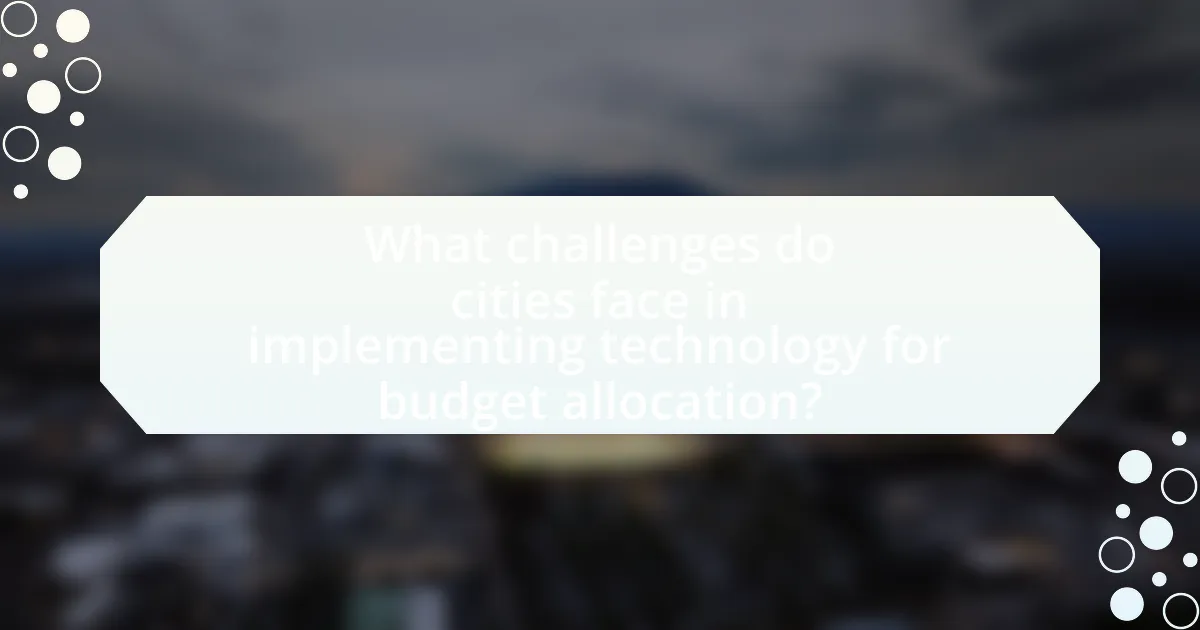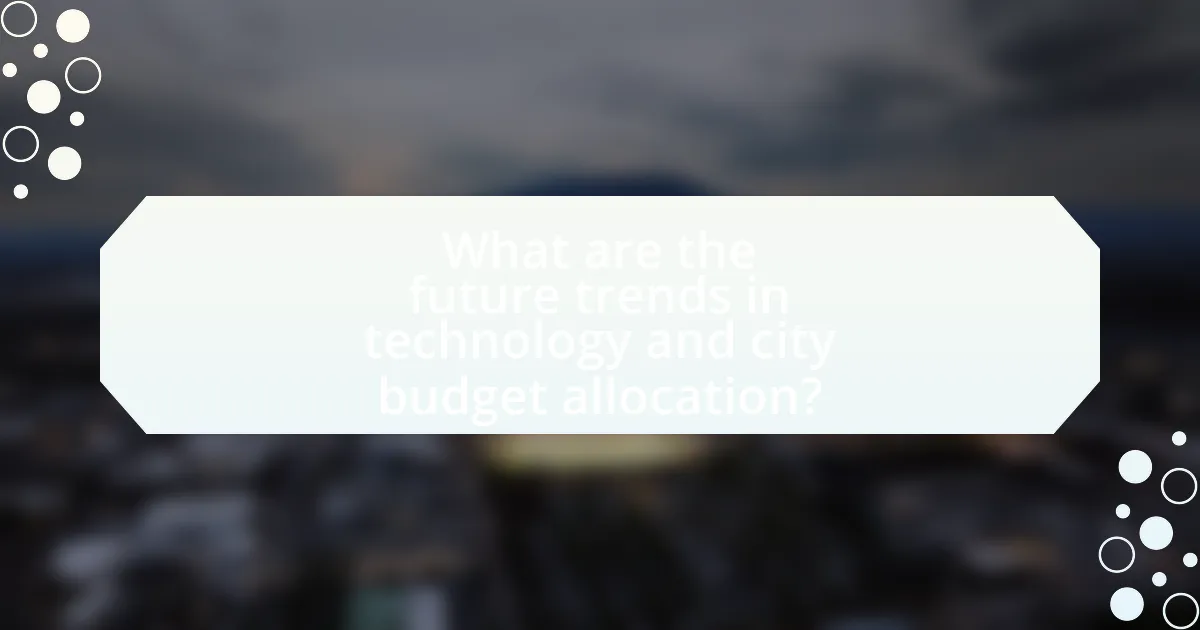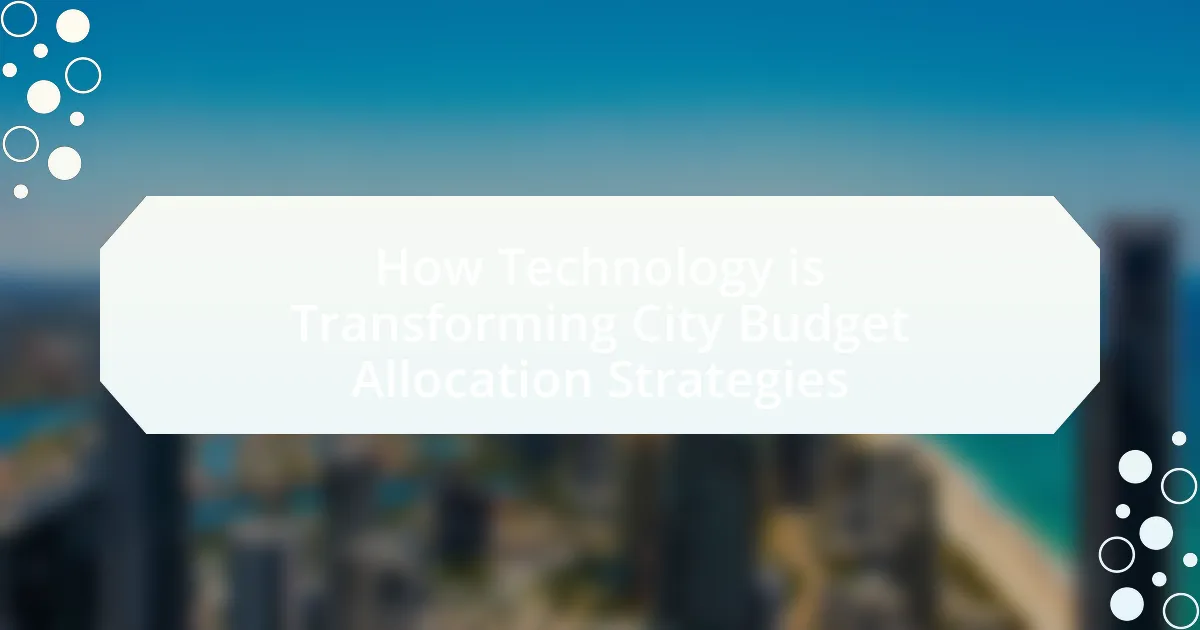Technology is significantly transforming city budget allocation strategies by enabling data-driven decision-making and enhancing transparency. Key technologies such as data analytics, geographic information systems (GIS), and artificial intelligence are being utilized to assess community needs, optimize resource allocation, and improve financial forecasting. The integration of these technologies not only fosters public engagement and accountability but also addresses challenges such as budget constraints and resistance to change. As cities increasingly adopt innovative solutions, the future of budget allocation will likely focus on smart city initiatives and participatory budgeting platforms, ensuring that financial decisions align with community priorities and enhance overall governance.

How is Technology Transforming City Budget Allocation Strategies?
Technology is transforming city budget allocation strategies by enabling data-driven decision-making and enhancing transparency. Cities are increasingly utilizing advanced analytics, geographic information systems (GIS), and real-time data collection to assess community needs and allocate resources more effectively. For instance, cities like Los Angeles have implemented data analytics platforms that analyze spending patterns and service delivery outcomes, leading to more informed budgetary decisions. Additionally, technology facilitates public engagement through online platforms, allowing citizens to participate in budget discussions and prioritize funding areas, which fosters accountability and responsiveness in government spending.
What are the key technologies influencing city budget allocation?
Key technologies influencing city budget allocation include data analytics, geographic information systems (GIS), and cloud computing. Data analytics enables cities to analyze spending patterns and forecast future needs, leading to more informed budget decisions. Geographic information systems provide spatial analysis capabilities, allowing city planners to visualize resource distribution and prioritize funding based on geographic needs. Cloud computing facilitates real-time data sharing and collaboration among departments, enhancing transparency and efficiency in budget management. These technologies collectively improve decision-making processes and resource allocation in urban governance.
How do data analytics enhance budget decision-making?
Data analytics enhance budget decision-making by providing data-driven insights that improve resource allocation and financial forecasting. By analyzing historical spending patterns and current financial data, city officials can identify trends, optimize budget allocations, and make informed decisions that align with community needs. For instance, a study by the Urban Institute found that cities using data analytics for budget planning experienced a 15% increase in budget efficiency, demonstrating the tangible benefits of integrating analytics into financial strategies.
What role does artificial intelligence play in budget forecasting?
Artificial intelligence plays a crucial role in budget forecasting by enhancing accuracy and efficiency in financial predictions. AI algorithms analyze vast datasets, identifying patterns and trends that human analysts may overlook, leading to more reliable forecasts. For instance, a study by McKinsey & Company found that organizations using AI for budgeting can improve forecasting accuracy by up to 30%. This capability allows city planners to allocate resources more effectively, ensuring that budget decisions are data-driven and aligned with community needs.
Why is technology adoption crucial for modern city budgeting?
Technology adoption is crucial for modern city budgeting because it enhances efficiency, transparency, and data-driven decision-making. By integrating advanced technologies such as data analytics, cities can analyze spending patterns and forecast future budget needs more accurately. For instance, a study by the McKinsey Global Institute found that cities leveraging big data can improve their budgeting processes by up to 30%, leading to more effective allocation of resources. Additionally, technology facilitates real-time tracking of expenditures, which increases accountability and reduces the risk of fraud. This combination of improved efficiency and transparency underscores the importance of technology in contemporary city budgeting practices.
How does technology improve transparency in budget allocation?
Technology improves transparency in budget allocation by enabling real-time tracking and reporting of financial data. Digital platforms allow stakeholders to access budget information easily, fostering accountability and informed decision-making. For instance, cities using open data initiatives can publish budgetary details online, allowing citizens to scrutinize expenditures and understand funding priorities. A study by the World Bank found that transparency initiatives, supported by technology, can lead to a 20% increase in public trust in government financial management. This demonstrates that technology not only enhances visibility but also strengthens civic engagement in budgetary processes.
What impact does technology have on citizen engagement in budgeting?
Technology significantly enhances citizen engagement in budgeting by providing platforms for transparency, participation, and feedback. Digital tools such as online budgeting portals and mobile applications allow citizens to access budget information easily, participate in discussions, and express their preferences regarding budget allocations. For instance, cities like San Francisco have implemented participatory budgeting platforms that enable residents to propose and vote on projects, resulting in increased civic involvement and satisfaction. Research indicates that when citizens are actively engaged through technology, they are more likely to understand budgetary processes and contribute to decision-making, leading to more equitable and effective allocation of resources.

What challenges do cities face in implementing technology for budget allocation?
Cities face several challenges in implementing technology for budget allocation, including high costs, data integration issues, and resistance to change. The financial burden of acquiring and maintaining advanced technology can strain municipal budgets, making it difficult for cities to justify the investment. Additionally, integrating new technology with existing systems often presents technical difficulties, as disparate data sources may not communicate effectively, leading to inefficiencies. Furthermore, stakeholders, including city officials and employees, may resist adopting new technologies due to fear of job displacement or a lack of familiarity with digital tools, hindering successful implementation. These challenges are documented in various studies, such as the “Smart Cities: A Toolkit for Leaders” by the National League of Cities, which highlights the importance of addressing these barriers to enhance budget allocation processes.
What are the common barriers to technology adoption in city budgeting?
Common barriers to technology adoption in city budgeting include limited financial resources, resistance to change among staff, lack of technical expertise, and concerns about data security. Limited financial resources hinder cities from investing in new technologies, as budget constraints often prioritize immediate needs over long-term technological improvements. Resistance to change among staff can impede the implementation of new systems, as employees may be accustomed to traditional budgeting methods and hesitant to adopt new processes. Additionally, a lack of technical expertise can prevent effective utilization of advanced budgeting tools, leading to underperformance. Finally, concerns about data security can create apprehension regarding the adoption of technology, as cities must ensure that sensitive financial information is protected from breaches.
How do budget constraints affect technology investments?
Budget constraints significantly limit technology investments by forcing organizations to prioritize essential projects over innovative solutions. When budgets are tight, decision-makers often focus on immediate needs and cost-saving measures, which can lead to underinvestment in emerging technologies that could enhance efficiency or service delivery. For instance, a study by Gartner in 2022 indicated that 60% of public sector organizations reported reduced technology budgets, resulting in delayed digital transformation initiatives. This trend illustrates how financial limitations can stifle innovation and hinder the adoption of advanced technologies that could improve city services and operations.
What skills are needed for city officials to effectively use new technologies?
City officials need skills in data analysis, digital literacy, and project management to effectively use new technologies. Data analysis enables officials to interpret and leverage data for informed decision-making, which is crucial in budget allocation strategies. Digital literacy ensures that officials can navigate and utilize various technological tools and platforms, enhancing their operational efficiency. Project management skills are essential for overseeing technology implementation and ensuring that projects align with city goals and budgets. These skills collectively empower city officials to harness technology for improved governance and resource allocation.
How can cities overcome these challenges?
Cities can overcome challenges in budget allocation by leveraging data analytics and technology to enhance decision-making processes. Implementing advanced data management systems allows city officials to analyze spending patterns, identify inefficiencies, and allocate resources more effectively. For instance, cities like Los Angeles have utilized predictive analytics to forecast budget needs, resulting in a more strategic allocation of funds. Additionally, engaging citizens through digital platforms fosters transparency and accountability, ensuring that budget decisions reflect community priorities. This approach not only improves resource management but also builds public trust, as evidenced by increased citizen participation in budget discussions in cities that have adopted such technologies.
What strategies can be employed to foster a culture of innovation?
To foster a culture of innovation, organizations should implement strategies such as encouraging open communication, promoting cross-functional collaboration, and providing resources for experimentation. Open communication allows employees to share ideas freely, which can lead to innovative solutions. For instance, companies like Google have adopted “20% time,” where employees can spend a portion of their workweek on projects of their choice, resulting in successful products like Gmail. Promoting cross-functional collaboration breaks down silos and encourages diverse perspectives, enhancing creativity. Additionally, providing resources for experimentation, such as funding for pilot projects, empowers teams to test new ideas without the fear of failure, as seen in organizations that allocate specific budgets for innovation initiatives. These strategies collectively create an environment conducive to continuous improvement and creative problem-solving.
How can partnerships with tech companies enhance budget strategies?
Partnerships with tech companies can enhance budget strategies by providing advanced data analytics and innovative tools that improve financial decision-making. These collaborations enable cities to leverage real-time data for more accurate forecasting and resource allocation, ultimately leading to more efficient budget management. For instance, cities that have partnered with tech firms like IBM and Microsoft have reported significant improvements in their budgeting processes, with some achieving up to a 30% increase in operational efficiency through the use of predictive analytics and cloud-based budgeting solutions. This evidence demonstrates that integrating technology into budget strategies can lead to more informed and effective financial planning.

What are the future trends in technology and city budget allocation?
Future trends in technology and city budget allocation include increased reliance on data analytics, smart city technologies, and participatory budgeting platforms. Cities are adopting advanced data analytics to optimize resource allocation, enabling more informed decision-making based on real-time data. For instance, the use of Geographic Information Systems (GIS) allows city planners to visualize and analyze spatial data, leading to more efficient infrastructure investments. Additionally, smart city technologies, such as IoT sensors, enhance operational efficiency and reduce costs by monitoring utilities and traffic patterns. Participatory budgeting platforms empower citizens to engage in the budget process, ensuring that allocations reflect community needs and priorities. These trends are supported by studies indicating that cities leveraging technology can improve budget transparency and accountability, ultimately leading to better fiscal outcomes.
How will emerging technologies shape future budget strategies?
Emerging technologies will significantly shape future budget strategies by enabling data-driven decision-making and enhancing efficiency in resource allocation. Technologies such as artificial intelligence, big data analytics, and blockchain provide municipalities with tools to analyze spending patterns, forecast future needs, and ensure transparency in financial transactions. For instance, cities that have adopted AI-driven analytics have reported up to a 30% increase in budget efficiency by identifying wasteful expenditures and optimizing service delivery. Additionally, blockchain technology can enhance accountability in budget management by providing immutable records of transactions, thereby reducing fraud and increasing public trust. These advancements indicate a shift towards more strategic, evidence-based budgeting processes that can adapt to changing urban needs.
What potential does blockchain hold for budget transparency?
Blockchain holds significant potential for budget transparency by enabling immutable and publicly accessible records of financial transactions. This technology allows stakeholders, including citizens and government officials, to track budget allocations and expenditures in real-time, reducing opportunities for corruption and mismanagement. For instance, a study by the World Economic Forum highlights that blockchain can enhance accountability by providing a transparent audit trail, which can be verified by any party without the need for intermediaries. This level of transparency fosters trust in public financial management and encourages civic engagement in budgetary processes.
How might smart city initiatives influence budget priorities?
Smart city initiatives can significantly influence budget priorities by reallocating funds towards technology-driven infrastructure and services. These initiatives often require investments in data analytics, IoT devices, and sustainable energy solutions, which can lead to a shift in funding from traditional sectors like road maintenance to smart transportation systems. For example, cities implementing smart traffic management systems have reported reductions in congestion and improved public safety, prompting budget adjustments to support ongoing technology integration. Furthermore, studies indicate that cities adopting smart technologies can achieve cost savings of up to 30% in operational expenses, reinforcing the need to prioritize technology in budget planning.
What best practices should cities adopt for effective technology integration?
Cities should adopt a strategic framework for technology integration that includes stakeholder engagement, data-driven decision-making, and continuous evaluation. Engaging stakeholders ensures that the needs and perspectives of the community are considered, which can lead to more effective technology solutions. Data-driven decision-making allows cities to allocate resources efficiently by analyzing performance metrics and outcomes, as evidenced by cities like San Francisco, which improved service delivery through data analytics. Continuous evaluation of technology initiatives helps cities adapt and optimize their strategies over time, ensuring that investments yield the desired results.
How can cities ensure continuous improvement in budget allocation strategies?
Cities can ensure continuous improvement in budget allocation strategies by implementing data-driven decision-making processes. Utilizing advanced analytics and real-time data allows city officials to assess the effectiveness of current budget allocations and identify areas for optimization. For instance, cities like San Francisco have adopted performance-based budgeting, which links funding to measurable outcomes, thereby enhancing accountability and transparency. This approach has led to more efficient use of resources, as evidenced by a 20% increase in service delivery efficiency reported in various municipal studies. By continuously analyzing data and adjusting strategies accordingly, cities can adapt to changing needs and improve overall fiscal health.
What role does community feedback play in refining budget processes?
Community feedback plays a crucial role in refining budget processes by ensuring that the allocation of resources aligns with the actual needs and priorities of residents. This input allows city officials to identify gaps in services and adjust funding accordingly, leading to more effective and responsive budgeting. For instance, cities that have implemented participatory budgeting initiatives, such as Porto Alegre in Brazil, have seen increased citizen engagement and satisfaction, demonstrating that community involvement directly influences budget decisions and enhances transparency.
What practical steps can cities take to enhance their budget allocation strategies using technology?
Cities can enhance their budget allocation strategies using technology by implementing data analytics tools to assess spending patterns and identify areas for cost savings. By utilizing software that aggregates and analyzes financial data, cities can make informed decisions based on real-time insights, leading to more efficient resource allocation. For instance, cities like Los Angeles have adopted performance-based budgeting systems that leverage data to prioritize funding for programs that demonstrate measurable outcomes, resulting in a more effective use of taxpayer dollars. Additionally, integrating citizen engagement platforms allows residents to provide input on budget priorities, fostering transparency and accountability in the budgeting process. This approach not only aligns spending with community needs but also enhances public trust in government financial decisions.

Leave a Reply